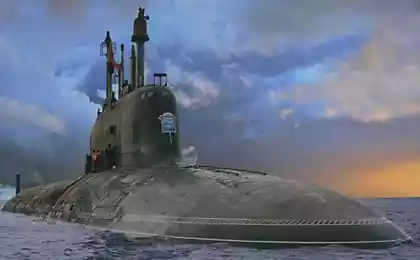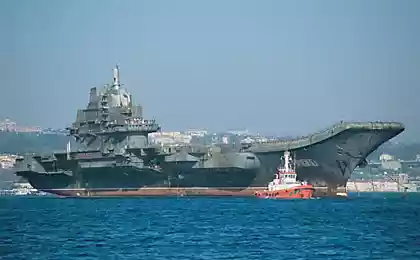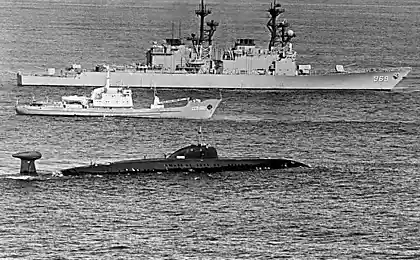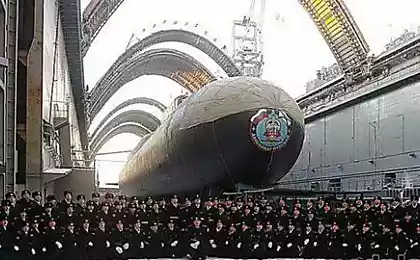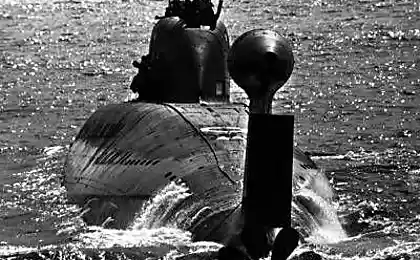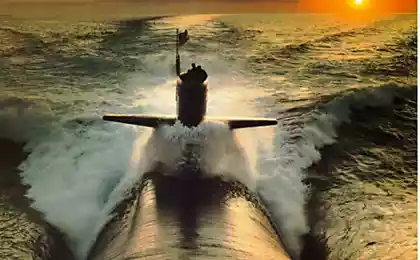2578
Analysis of loss of nuclear submarine of the Soviet Navy and the US Navy
Water and cold. Darkness.
And somewhere above the sound of metal.
There is no strength to say: we are here, here ...
Gone hope, tired of waiting.
Will be 14 photos + text
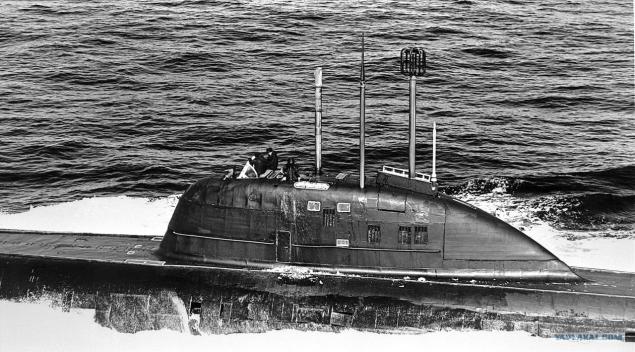
Endless ocean keeps its secrets. Somewhere, under the dark vaults of the waves are thousands of fragments of vessels, each of which has its own unique history and the fate of the tragic death.
In 1963, the thickness of sea water crushed the most modern American submarine "Thresher". Half a century ago, is hard to believe - undefeated Poseidon, draw strength from the flames of a nuclear reactor capable without a single surfacing circumnavigate the globe, appeared weak as a worm before the onslaught of ruthless elements.
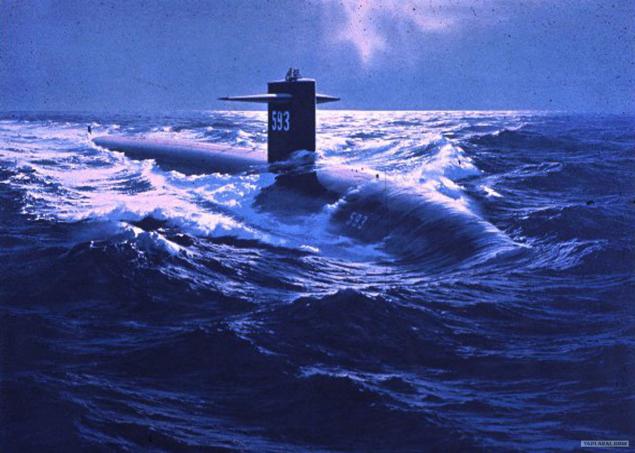
"We have a positive angle increases ... We are trying to equalize the north ... 900 ..." - the last message "Thrasher" can not convey the full horror of what experienced submariners dying. Who could imagine that a two-day test campaign, accompanied by a rescue tug "Skylark" could result in such disasters?
Cause of death "Thrasher" is a mystery. The main hypothesis: when immersed in the maximum depth of the water supply occurred in rugged boats - has been automatically shut down the reactor, and devoid of course the submarine fell into the abyss, taking with them 129 lives.
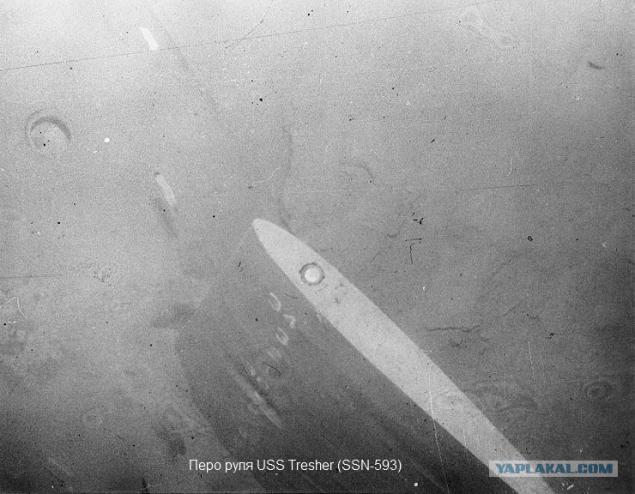
Soon, a terrible story will be continued - the Americans lost another icebreaker crew: in 1968 in the Atlantic had disappeared multipurpose nuclear submarine "Scorpion».
In contrast to the "Thrasher", which was maintained until the last second sonar communication, death of "Scorpio" was complicated by the lack though a little clear ideas about the coordinates of the crash site. Five months of fruitless search continued until the Yankees not decrypt data with the deep-water stations systems SOSUS (network of buoys, the US Navy hydrophones to track Soviet submarines) - on records from May 22, 1968 was discovered a loud bang, similar to the destruction of the pressure hull of the submarine. Further, by triangulation restored approximate location of the lost boat.
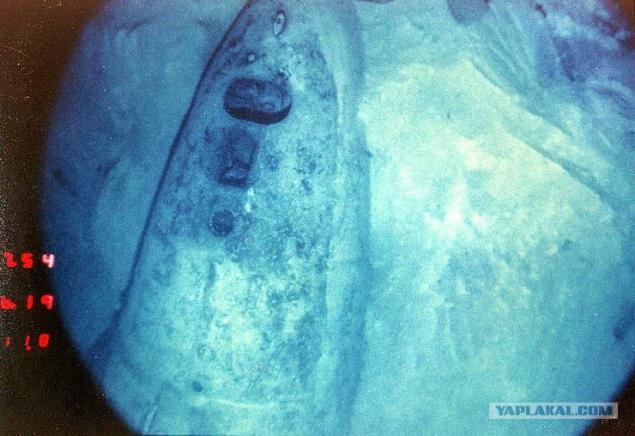
Fragments "Scorpion" were found at a depth of 3000 meters in the middle of the Atlantic Ocean, 740 km south-west of the Azores. The official version of the death of boats connects with a detonation of ammunition torpedoes (almost like a "Kursk"!). There are more exotic legend according to which, "Scorpion" Russian drowned in retaliation for the deaths of K-129.
The mystery of the death of "Scorpion" still excites the minds of the sailors - in November 2012. The organization of veterans of the US Navy submarine has proposed to launch a new investigation to establish the truth about the death of the American boat.
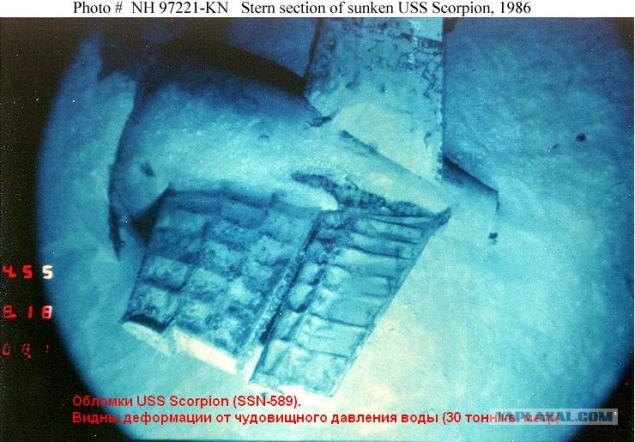
The most dangerous situation around K-219 - on board the submarine, in addition to two nuclear reactors were 15 ballistic missile submarine-based * P-21 with 45 thermonuclear warheads. 3 October 1986 there was a depressurization of the missile silo №6, which led to the explosion of a ballistic missile. Crippled ship survivability demonstrated fantastic, managing to emerge from a depth of 350 meters, with damage to the hull and flooded four (rocket) tray.
* Whole project was supposed 16 SLBMs, but in 1973 at the K-219 has occurred a similar case - the explosion of the liquid rocket. As a result of "unfortunate" the boat remained in the ranks, but lost silos №15.
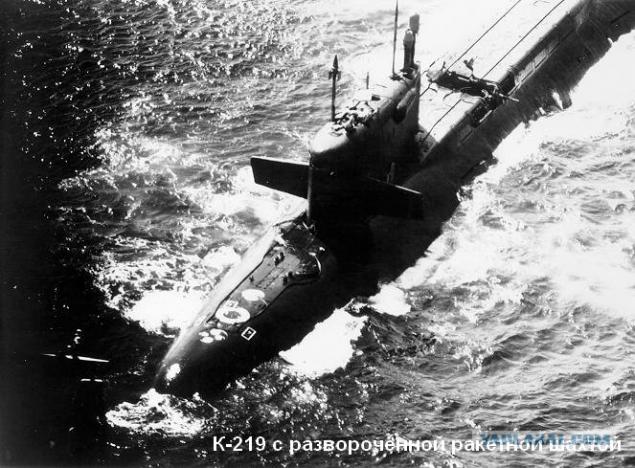
Less than 48 hours as the wreckage of the American "Scorpion" sank to the seabed, the ocean there was a new tragedy. In the experimental nuclear submarine K-27 Soviet Navy out of control reactor with liquid metal coolant. Nightmare unit, in whose veins boiling molten lead, "dirtied" by radioactive emissions all compartments, the crew received a terrible dose, 9 submariners died of acute radiation sickness. Despite the heavy radiation accident, the Soviet sailors managed to bring the boat to the base in Gremikha.
K-27 turned into a pile of metal unfit for action with positive buoyancy, exuding deadly gamma rays. The question of the future fate of a unique ship hung in the air, finally, in 1981 it was decided to flood the submarine crash in one of the bays on the New Earth. In memory of descendants. Maybe they'll find a way to safely dispose of floating "Fukushima»?
But long before "the last dive," K-27, a grouping of nuclear submarines at the bottom of the Atlantic has expanded the submarine K-8. One of the first-born of the nuclear fleet, third submarine in the ranks of the Soviet Navy, sank during a fire in the Bay of Biscay April 12, 1970. 80 hours was a struggle for survival of the ship, during which time the sailors had time to shut down the reactor and evacuated part of the crew on board approached the Bulgarian ship.
The loss of the K-8 and 52 sailors were the first official loss of Soviet nuclear fleet. Currently, the nuclear submarine wrecks lie at a depth of 4680 meters 250 miles from the coast of Spain.
In the 1980s, the Navy lost in military campaigns a couple of nuclear submarines - strategic missile submarine K-219 destination and a unique "titanic" K-278 submarine "Komsomolets".
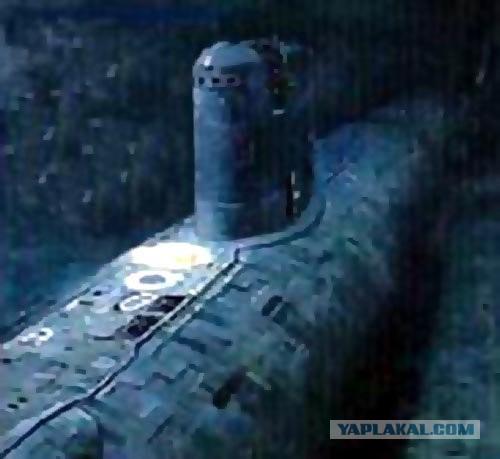
Alas, no outrageous performance characteristics are not saved "Komsomolets" - the submarine was the victim of a banal fire, complicated by the lack of clear understanding of the tactics of the struggle for survival on bezkingstonnyh boats. The blazing compartments and ice water lost 42 sailor. Nuclear submarine sank at a depth of 1858 meters, becoming the subject of fierce debate among shipbuilders and seamen in the quest to find the "culprit».
New times have brought new challenges. Bacchanalia "free market" multiplied by "limited funding", the destruction of the fleet of supply and the mass dismissal of experienced submariners inevitably led to disaster. And it is not long in coming.
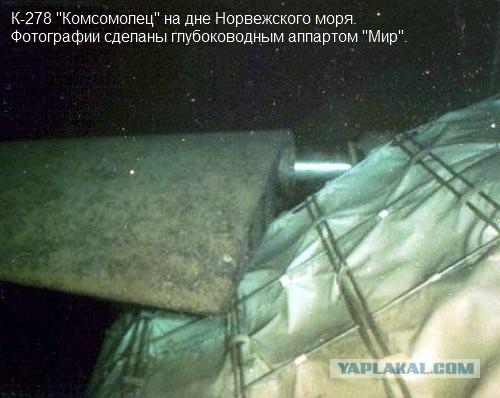
August 12, 2000 on the communication did not come out the K-141 "Kursk". The official cause of the tragedy - a spontaneous explosion of the "long" torpedo. Unofficial version - from the dreadful heresy in the style of "submarine in troubled waters" by French director Jean-Michel Carre up plausible hypotheses about collision with the aircraft carrier "Admiral Kuznetsov" and released a torpedo from a US submarine "Toledo" (the motive is unclear). < br />
The nuclear submarine - "the killer of aircraft carriers" displacement of 24,000 tons. The depth at the site of sinking the submarine was 108 meters, "a steel coffin" trapped 118 people ...
The saga of a failed operation to rescue the crew of lying on the ground of "Kursk" shocked the whole of Russia. We all remember the smiling face on the TV next to the admiral bastard chase: "The situation is under control. With a crew contacted, the emergency boat organized air supply. "
Then he had an operation on lifting the "Kursk". Sawed-off the first compartment (why ??), the captain found a letter Kolesnikov ... whether the second page? Someday we will learn the truth about those events. And, certainly, very surprised his naivete.
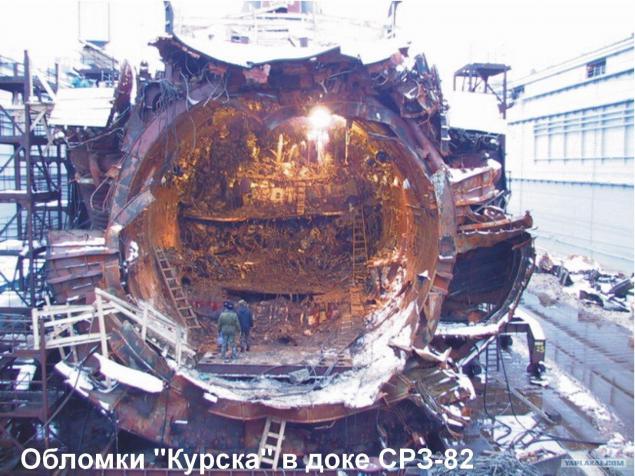
August 30, 2003 there was another tragedy, hidden in the gray twilight of naval weekdays - while towing a breaker on an old sunk submarine K-159. The reason - the loss of buoyancy due to the poor technical condition of the boat. She still lies at a depth of 170 meters off the island of Kildin, on the way to Murmansk.
Periodically raised the issue of lifting and disposal of radioactive piles of metal, but so far it is not moving beyond words.
Total to date on the bottom of the oceans lie fragments of seven nuclear submarines:
- Two American, "Thrasher" and "Scorpion»
- Five Soviet: K-8, K-27, K-219, K-278 and K-159.
However, this is not a complete list. In the history of the Russian Navy marked by a number of incidents, which were reported by Tass, each of which killed nuclear submarines.
For example, the August 20, 1980 there was a serious accident in the Philippine Sea - in the fight against the fire aboard the K-122 killed 14 sailors. The crew was able to save their Premier League lead and burnt the boat towed to its home base. Alas, received injuries were such that the recovery of the boat considered unwise. After 15 years of sludge K-122 has been used to FEP "Zvezda».
Another bitter case, known as "radiation accident in the Bay of Chazhma" occurred in 1985 in the Far East. During recharge the reactor nuclear submarine K-431 floating crane swayed on a wave and "ripped" lattice control of the reactor of the submarine. The reactor involved and immediately went to the other-wordly operation turned into a "dirty-bomb", the so-called "Pop." In a flash disappeared 11 officers standing nearby. According to eyewitnesses, 12-ton reactor cover flew up a couple of hundred meters and then fell back to the boat, almost severing it in half. Start a fire and the release of radioactive dust finally turned K-431 and nearby nuclear submarine K-42 in floating coffins unfit for action. Both emergency submarines were sent to the scrap.
When it comes to accidents on nuclear submarines, not to mention the K-19, received the Navy saying the nickname "Hiroshima". The boat, at least four times became a source of serious problems. Especially memorable first military campaign and the reactor accident July 3, 1961. K-19, heroically rescued, but the episode with the reactor nearly cost the life of the first Soviet missile.
After reviewing the list of the victims of submarines, from the layman may be vile belief: Russian ships are not able to manage. The prosecution laughing. The Yankees lost only two atomic boats - "Thrasher" and "Scorpion". At the same time the Russian Navy has lost almost a dozen nuclear submarines, not including diesel-electric submarines (the Yankees do not build diesel-electric boats from the 1950s). How do you explain this paradox? The fact that the Soviet Navy nuclear-powered Russian Mongols ruled Krivorukov?
Something tells me that there is another explanation for the paradox. Let's try to find it together.
It should be noted that the attempt to "dump" all the failures of the difference in the number of submarines in the Navy of the USSR and the US Navy deliberately useless. Altogether during the existence of the nuclear submarine fleet through the hands of our sailors have been about 250 submarines (from R-3 to the modern "Boreas"), the Americans have been several smaller ≈ 200 units. However, nuclear submarines from the Yankees appeared earlier and operated two to three times more intense (just look at the ratio of operational voltage SSBN: 0, 17 - 0, 24, 0, and our 5 - 0, 6 at the American missile). It is obvious that the whole thing is not the number of boats ... But then what is?
Much depends on the method of calculation. As the old joke: "does not matter, as did the main thing - as they found." A thick plume of accidents and fatal PE stretches through the entire history of the nuclear fleet, regardless of the flag of the submarine.
- February 9, 2001 multipurpose atomic submarine of the US Navy "Greenville" rammed a Japanese fishing schooner "Ehime Maru". 9 Killed Japanese fisherfolk, the US Navy submarine disappeared from the scene without offering any assistance to persons in distress.
Nonsense! - Asked the Yankees. Navigation incident - Weekday in any fleet. In the summer of 1973 the Soviet atomic submarine K-56 collided with research vessel "Akademik Berg." Killed 27 sailors.
But at the Russian boat sank right at the pier! Here you go:
September 13, 1985 K-429 lay on the ground at the pier in Krasheninnikov bay.
So what?! - May argue our sailors. In the Yankees was the same case:
May 15, 1969 the US Navy nuclear submarine "Gitarro" sank right outside the harbor wall. The reason - the ordinary negligence.
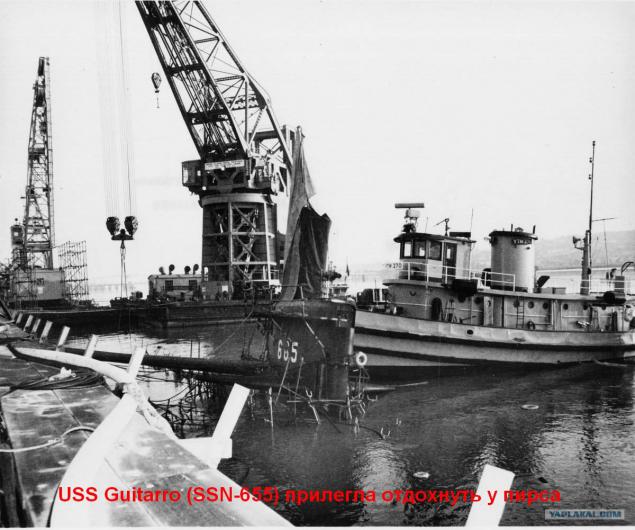
Americans pocheshut head and remember, May 8, 1982 in the central post submarine K-123 ("Submarine Fighter" 705-year project, the reactor with LMC) received the original report: "I see a silver metal spreads on deck." To break through the first loop reactor, radioactive alloy of lead and bismuth as "soiled" boat to clean that K-123 took 10 years. Fortunately, none of the sailors did not perish.
Russian only sad grin and tactfully hint to the Americans, as the USS Dace (SSN-607), accidentally "threw" into the Thames (River in the United States), two tons of radioactive liquid from the first circuit, "dirtied" the entire naval base in Groton.
Stop!
So we will not achieve anything. It makes no sense to demonize each other and remember the ugly moments in history.
It is clear that a huge fleet of hundreds of ships is rich soil for any emergency - every day somewhere there is smoke, something falls, blows or sits on stones.
The true measure of a major accident are leading to the destruction of the ships. "Thresher", "Scorpio" ... noted there other cases in which US Navy nuclear submarines in military campaigns received heavy damage and permanently excluded from the Navy?
Yes, such cases happen.
In 1986, on the rocks in the Irish Sea crashed strategic bomber of the US Navy, "Nathaniel Greene." Damage to housing, rudders and ballast tanks were so great that the boat had to be sent to the scrap.
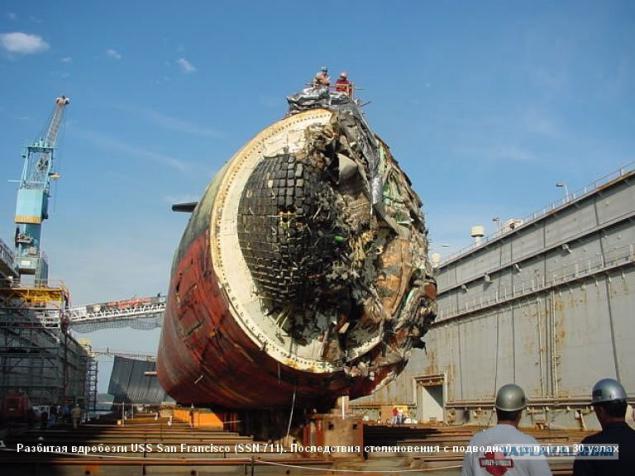
February 11, 1992. Barencevo sea. The multi-purpose nuclear submarine "Baton Rouge" was faced with Russian titanium "Barracuda." Boats faced successfully - repairs on the B-276 took six months, and the history of USS Baton Rouge (SSN-689) was much sadder. Collision with Russian titanium boat led to the stresses and microcracks in the submarine pressure hull. "Baton Rouge" limped to the base and soon ceased to exist.
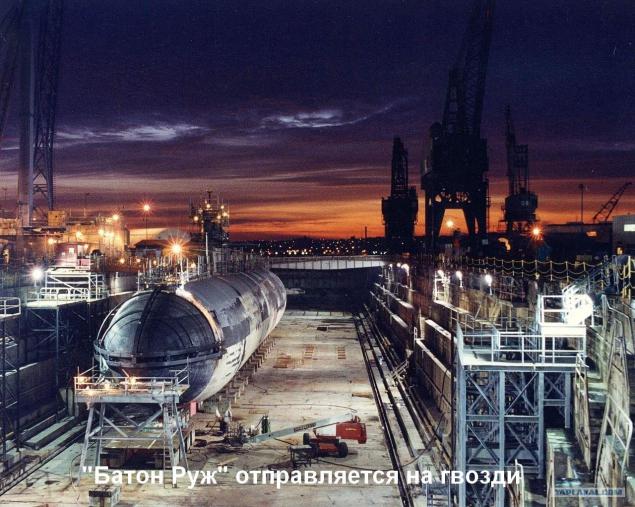
It is not fair! - Notice the attentive reader. Americans purely navigational error on the ships of the US Navy was virtually no accidents with damage to the reactor core. On the Russian Navy is different: lit compartments on deck lashed molten coolant. There is a design errors and improper use of equipment.
And it is true. Domestic submarine fleet reliability traded on the outrageous specifications boats. The construction of submarines the Navy always has a high degree of novelty and more innovative solutions. Testing of new technologies are often carried out directly in the military campaigns. Fastest (K-222), the deep-water (R-278), the largest (Project 941 "Akula") and the most secretive Boat (Project 945A "Condor") have been created in our country. And if the rebuke "Condor" and "Shark" there is nothing, the operation of the other "champions" are regularly accompanied by major technical problems.
Was it the right decision: the weapon and the depth of immersion in exchange for reliability? We can not answer this question. History does not know the subjunctive mood, the only thing I wanted to convey to the reader: the high accident rate on Soviet submarines - not errors of designers and crew error. Often, it was inevitable. The high price paid for the unique characteristics of submarines.
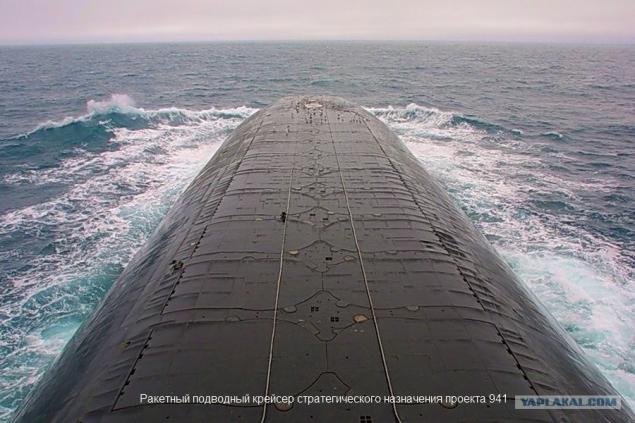
I have all the comrades!

Source:
And somewhere above the sound of metal.
There is no strength to say: we are here, here ...
Gone hope, tired of waiting.
Will be 14 photos + text

Endless ocean keeps its secrets. Somewhere, under the dark vaults of the waves are thousands of fragments of vessels, each of which has its own unique history and the fate of the tragic death.
In 1963, the thickness of sea water crushed the most modern American submarine "Thresher". Half a century ago, is hard to believe - undefeated Poseidon, draw strength from the flames of a nuclear reactor capable without a single surfacing circumnavigate the globe, appeared weak as a worm before the onslaught of ruthless elements.

"We have a positive angle increases ... We are trying to equalize the north ... 900 ..." - the last message "Thrasher" can not convey the full horror of what experienced submariners dying. Who could imagine that a two-day test campaign, accompanied by a rescue tug "Skylark" could result in such disasters?
Cause of death "Thrasher" is a mystery. The main hypothesis: when immersed in the maximum depth of the water supply occurred in rugged boats - has been automatically shut down the reactor, and devoid of course the submarine fell into the abyss, taking with them 129 lives.

Soon, a terrible story will be continued - the Americans lost another icebreaker crew: in 1968 in the Atlantic had disappeared multipurpose nuclear submarine "Scorpion».
In contrast to the "Thrasher", which was maintained until the last second sonar communication, death of "Scorpio" was complicated by the lack though a little clear ideas about the coordinates of the crash site. Five months of fruitless search continued until the Yankees not decrypt data with the deep-water stations systems SOSUS (network of buoys, the US Navy hydrophones to track Soviet submarines) - on records from May 22, 1968 was discovered a loud bang, similar to the destruction of the pressure hull of the submarine. Further, by triangulation restored approximate location of the lost boat.

Fragments "Scorpion" were found at a depth of 3000 meters in the middle of the Atlantic Ocean, 740 km south-west of the Azores. The official version of the death of boats connects with a detonation of ammunition torpedoes (almost like a "Kursk"!). There are more exotic legend according to which, "Scorpion" Russian drowned in retaliation for the deaths of K-129.
The mystery of the death of "Scorpion" still excites the minds of the sailors - in November 2012. The organization of veterans of the US Navy submarine has proposed to launch a new investigation to establish the truth about the death of the American boat.

The most dangerous situation around K-219 - on board the submarine, in addition to two nuclear reactors were 15 ballistic missile submarine-based * P-21 with 45 thermonuclear warheads. 3 October 1986 there was a depressurization of the missile silo №6, which led to the explosion of a ballistic missile. Crippled ship survivability demonstrated fantastic, managing to emerge from a depth of 350 meters, with damage to the hull and flooded four (rocket) tray.
* Whole project was supposed 16 SLBMs, but in 1973 at the K-219 has occurred a similar case - the explosion of the liquid rocket. As a result of "unfortunate" the boat remained in the ranks, but lost silos №15.

Less than 48 hours as the wreckage of the American "Scorpion" sank to the seabed, the ocean there was a new tragedy. In the experimental nuclear submarine K-27 Soviet Navy out of control reactor with liquid metal coolant. Nightmare unit, in whose veins boiling molten lead, "dirtied" by radioactive emissions all compartments, the crew received a terrible dose, 9 submariners died of acute radiation sickness. Despite the heavy radiation accident, the Soviet sailors managed to bring the boat to the base in Gremikha.
K-27 turned into a pile of metal unfit for action with positive buoyancy, exuding deadly gamma rays. The question of the future fate of a unique ship hung in the air, finally, in 1981 it was decided to flood the submarine crash in one of the bays on the New Earth. In memory of descendants. Maybe they'll find a way to safely dispose of floating "Fukushima»?
But long before "the last dive," K-27, a grouping of nuclear submarines at the bottom of the Atlantic has expanded the submarine K-8. One of the first-born of the nuclear fleet, third submarine in the ranks of the Soviet Navy, sank during a fire in the Bay of Biscay April 12, 1970. 80 hours was a struggle for survival of the ship, during which time the sailors had time to shut down the reactor and evacuated part of the crew on board approached the Bulgarian ship.
The loss of the K-8 and 52 sailors were the first official loss of Soviet nuclear fleet. Currently, the nuclear submarine wrecks lie at a depth of 4680 meters 250 miles from the coast of Spain.
In the 1980s, the Navy lost in military campaigns a couple of nuclear submarines - strategic missile submarine K-219 destination and a unique "titanic" K-278 submarine "Komsomolets".

Alas, no outrageous performance characteristics are not saved "Komsomolets" - the submarine was the victim of a banal fire, complicated by the lack of clear understanding of the tactics of the struggle for survival on bezkingstonnyh boats. The blazing compartments and ice water lost 42 sailor. Nuclear submarine sank at a depth of 1858 meters, becoming the subject of fierce debate among shipbuilders and seamen in the quest to find the "culprit».
New times have brought new challenges. Bacchanalia "free market" multiplied by "limited funding", the destruction of the fleet of supply and the mass dismissal of experienced submariners inevitably led to disaster. And it is not long in coming.

August 12, 2000 on the communication did not come out the K-141 "Kursk". The official cause of the tragedy - a spontaneous explosion of the "long" torpedo. Unofficial version - from the dreadful heresy in the style of "submarine in troubled waters" by French director Jean-Michel Carre up plausible hypotheses about collision with the aircraft carrier "Admiral Kuznetsov" and released a torpedo from a US submarine "Toledo" (the motive is unclear). < br />
The nuclear submarine - "the killer of aircraft carriers" displacement of 24,000 tons. The depth at the site of sinking the submarine was 108 meters, "a steel coffin" trapped 118 people ...
The saga of a failed operation to rescue the crew of lying on the ground of "Kursk" shocked the whole of Russia. We all remember the smiling face on the TV next to the admiral bastard chase: "The situation is under control. With a crew contacted, the emergency boat organized air supply. "
Then he had an operation on lifting the "Kursk". Sawed-off the first compartment (why ??), the captain found a letter Kolesnikov ... whether the second page? Someday we will learn the truth about those events. And, certainly, very surprised his naivete.

August 30, 2003 there was another tragedy, hidden in the gray twilight of naval weekdays - while towing a breaker on an old sunk submarine K-159. The reason - the loss of buoyancy due to the poor technical condition of the boat. She still lies at a depth of 170 meters off the island of Kildin, on the way to Murmansk.
Periodically raised the issue of lifting and disposal of radioactive piles of metal, but so far it is not moving beyond words.
Total to date on the bottom of the oceans lie fragments of seven nuclear submarines:
- Two American, "Thrasher" and "Scorpion»
- Five Soviet: K-8, K-27, K-219, K-278 and K-159.
However, this is not a complete list. In the history of the Russian Navy marked by a number of incidents, which were reported by Tass, each of which killed nuclear submarines.
For example, the August 20, 1980 there was a serious accident in the Philippine Sea - in the fight against the fire aboard the K-122 killed 14 sailors. The crew was able to save their Premier League lead and burnt the boat towed to its home base. Alas, received injuries were such that the recovery of the boat considered unwise. After 15 years of sludge K-122 has been used to FEP "Zvezda».
Another bitter case, known as "radiation accident in the Bay of Chazhma" occurred in 1985 in the Far East. During recharge the reactor nuclear submarine K-431 floating crane swayed on a wave and "ripped" lattice control of the reactor of the submarine. The reactor involved and immediately went to the other-wordly operation turned into a "dirty-bomb", the so-called "Pop." In a flash disappeared 11 officers standing nearby. According to eyewitnesses, 12-ton reactor cover flew up a couple of hundred meters and then fell back to the boat, almost severing it in half. Start a fire and the release of radioactive dust finally turned K-431 and nearby nuclear submarine K-42 in floating coffins unfit for action. Both emergency submarines were sent to the scrap.
When it comes to accidents on nuclear submarines, not to mention the K-19, received the Navy saying the nickname "Hiroshima". The boat, at least four times became a source of serious problems. Especially memorable first military campaign and the reactor accident July 3, 1961. K-19, heroically rescued, but the episode with the reactor nearly cost the life of the first Soviet missile.
After reviewing the list of the victims of submarines, from the layman may be vile belief: Russian ships are not able to manage. The prosecution laughing. The Yankees lost only two atomic boats - "Thrasher" and "Scorpion". At the same time the Russian Navy has lost almost a dozen nuclear submarines, not including diesel-electric submarines (the Yankees do not build diesel-electric boats from the 1950s). How do you explain this paradox? The fact that the Soviet Navy nuclear-powered Russian Mongols ruled Krivorukov?
Something tells me that there is another explanation for the paradox. Let's try to find it together.
It should be noted that the attempt to "dump" all the failures of the difference in the number of submarines in the Navy of the USSR and the US Navy deliberately useless. Altogether during the existence of the nuclear submarine fleet through the hands of our sailors have been about 250 submarines (from R-3 to the modern "Boreas"), the Americans have been several smaller ≈ 200 units. However, nuclear submarines from the Yankees appeared earlier and operated two to three times more intense (just look at the ratio of operational voltage SSBN: 0, 17 - 0, 24, 0, and our 5 - 0, 6 at the American missile). It is obvious that the whole thing is not the number of boats ... But then what is?
Much depends on the method of calculation. As the old joke: "does not matter, as did the main thing - as they found." A thick plume of accidents and fatal PE stretches through the entire history of the nuclear fleet, regardless of the flag of the submarine.
- February 9, 2001 multipurpose atomic submarine of the US Navy "Greenville" rammed a Japanese fishing schooner "Ehime Maru". 9 Killed Japanese fisherfolk, the US Navy submarine disappeared from the scene without offering any assistance to persons in distress.
Nonsense! - Asked the Yankees. Navigation incident - Weekday in any fleet. In the summer of 1973 the Soviet atomic submarine K-56 collided with research vessel "Akademik Berg." Killed 27 sailors.
But at the Russian boat sank right at the pier! Here you go:
September 13, 1985 K-429 lay on the ground at the pier in Krasheninnikov bay.
So what?! - May argue our sailors. In the Yankees was the same case:
May 15, 1969 the US Navy nuclear submarine "Gitarro" sank right outside the harbor wall. The reason - the ordinary negligence.

Americans pocheshut head and remember, May 8, 1982 in the central post submarine K-123 ("Submarine Fighter" 705-year project, the reactor with LMC) received the original report: "I see a silver metal spreads on deck." To break through the first loop reactor, radioactive alloy of lead and bismuth as "soiled" boat to clean that K-123 took 10 years. Fortunately, none of the sailors did not perish.
Russian only sad grin and tactfully hint to the Americans, as the USS Dace (SSN-607), accidentally "threw" into the Thames (River in the United States), two tons of radioactive liquid from the first circuit, "dirtied" the entire naval base in Groton.
Stop!
So we will not achieve anything. It makes no sense to demonize each other and remember the ugly moments in history.
It is clear that a huge fleet of hundreds of ships is rich soil for any emergency - every day somewhere there is smoke, something falls, blows or sits on stones.
The true measure of a major accident are leading to the destruction of the ships. "Thresher", "Scorpio" ... noted there other cases in which US Navy nuclear submarines in military campaigns received heavy damage and permanently excluded from the Navy?
Yes, such cases happen.
In 1986, on the rocks in the Irish Sea crashed strategic bomber of the US Navy, "Nathaniel Greene." Damage to housing, rudders and ballast tanks were so great that the boat had to be sent to the scrap.

February 11, 1992. Barencevo sea. The multi-purpose nuclear submarine "Baton Rouge" was faced with Russian titanium "Barracuda." Boats faced successfully - repairs on the B-276 took six months, and the history of USS Baton Rouge (SSN-689) was much sadder. Collision with Russian titanium boat led to the stresses and microcracks in the submarine pressure hull. "Baton Rouge" limped to the base and soon ceased to exist.

It is not fair! - Notice the attentive reader. Americans purely navigational error on the ships of the US Navy was virtually no accidents with damage to the reactor core. On the Russian Navy is different: lit compartments on deck lashed molten coolant. There is a design errors and improper use of equipment.
And it is true. Domestic submarine fleet reliability traded on the outrageous specifications boats. The construction of submarines the Navy always has a high degree of novelty and more innovative solutions. Testing of new technologies are often carried out directly in the military campaigns. Fastest (K-222), the deep-water (R-278), the largest (Project 941 "Akula") and the most secretive Boat (Project 945A "Condor") have been created in our country. And if the rebuke "Condor" and "Shark" there is nothing, the operation of the other "champions" are regularly accompanied by major technical problems.
Was it the right decision: the weapon and the depth of immersion in exchange for reliability? We can not answer this question. History does not know the subjunctive mood, the only thing I wanted to convey to the reader: the high accident rate on Soviet submarines - not errors of designers and crew error. Often, it was inevitable. The high price paid for the unique characteristics of submarines.

I have all the comrades!

Source:

